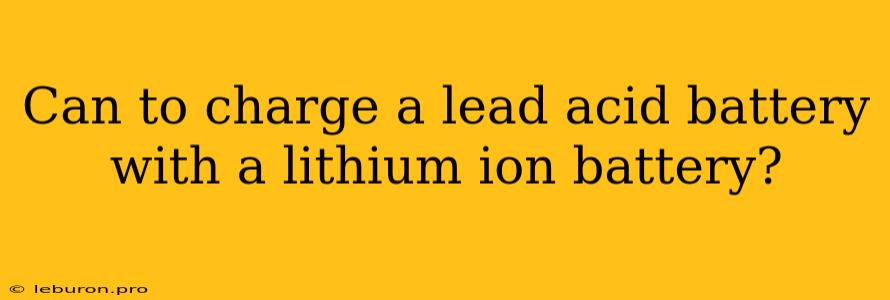The question of whether you can charge a lead acid battery with a lithium ion battery is a common one, especially as the popularity of lithium-ion batteries grows. While both battery types are essential for powering a variety of devices, their chemistry and voltage characteristics create challenges in direct charging. The core issue lies in the voltage differences and the potential risks involved. However, there are solutions that can be explored for converting the energy from a lithium-ion battery to charge a lead acid battery safely and effectively.
Understanding the Differences Between Lead Acid and Lithium-Ion Batteries
Before diving into the complexities of charging, it's essential to grasp the fundamental differences between lead acid and lithium-ion batteries.
Lead Acid Batteries:
- Chemistry: Lead acid batteries use a lead-acid electrolyte to store energy.
- Voltage: They typically operate at a nominal voltage of 12 volts.
- Charging: Lead acid batteries require a constant current charging method where the current is regulated until the battery reaches full charge.
- Safety: Lead acid batteries can release harmful fumes and require careful handling due to the presence of acid.
Lithium-Ion Batteries:
- Chemistry: Lithium-ion batteries utilize lithium ions moving between the anode and cathode to store energy.
- Voltage: They operate at higher voltages, ranging from 3.6 to 4.2 volts per cell.
- Charging: Lithium-ion batteries use a constant current and constant voltage charging method, with a sophisticated charging profile to protect the battery.
- Safety: Lithium-ion batteries are generally safer but can be prone to overheating or catching fire if mishandled.
Direct Charging: Why It's Not Recommended
Directly connecting a lithium-ion battery to a lead acid battery is not recommended due to the following reasons:
- Voltage mismatch: Lithium-ion batteries operate at a higher voltage than lead acid batteries. Attempting to charge a lead acid battery directly with a lithium-ion battery can lead to overcharging and damage to the lead acid battery.
- Charging currents: The charging currents required for lead acid and lithium-ion batteries differ significantly. A lithium-ion battery may not be able to deliver the required charging current for a lead acid battery.
- Safety risks: The voltage mismatch and potential for overcharging can create safety risks, including overheating and fire hazards.
Solutions for Charging a Lead Acid Battery with a Lithium-Ion Battery
While direct charging is not recommended, there are solutions that can be implemented to convert the energy from a lithium-ion battery to charge a lead acid battery safely and effectively:
1. DC-to-DC Converter:
- A DC-to-DC converter is an electronic circuit that can convert the higher voltage output of a lithium-ion battery to a lower voltage suitable for charging a lead acid battery.
- The converter regulates the current and voltage to ensure safe and efficient charging of the lead acid battery.
- It’s important to select a DC-to-DC converter that is specifically designed for charging lead acid batteries and rated for the appropriate power output.
2. Solar Panel Charging:
- If you have access to solar panels, you can use them to charge a lithium-ion battery and then use a DC-to-DC converter to charge the lead acid battery.
- This approach leverages solar energy and allows you to charge both batteries simultaneously.
- It’s important to note that solar panels require appropriate controllers to regulate the charging process and prevent overcharging.
3. Hybrid Charging Systems:
- Some hybrid systems incorporate both lithium-ion and lead acid batteries for optimal performance.
- These systems typically employ specialized charging circuits that manage the charging of both battery types independently while ensuring proper safety measures.
Conclusion
The ability to charge a lead acid battery with a lithium-ion battery depends on the approach taken. While directly connecting the two is not recommended due to voltage differences and safety risks, employing solutions such as DC-to-DC converters, solar panels, or hybrid charging systems allows for the safe and efficient charging of a lead acid battery with the energy stored in a lithium-ion battery. As technology advances, we can expect to see more innovative methods for transferring energy between different battery types, making it easier and safer to utilize the advantages of both lead acid and lithium-ion batteries in a variety of applications.
